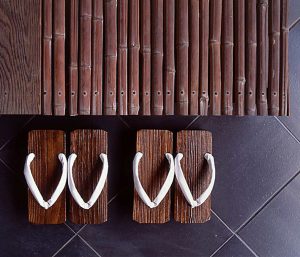A Brief History of Ryokans

Ryokans have been a part of Japanese culture for centuries. Some of the earliest ryokans were located on the Tokaido Highway that connected the capital city of Edo (modern Tokyo) and Kyoto, where the Imperial Palace was. It was a very busy highway as daimyo, samurai, traders, and others made their way between the two most popular destinations in the country. Ryokans were built to welcome these weary travelers who needed to rest and eat before continuing their long journey. Some ryokans were very simple, where townspeople offered extra rooms in their homes for travelers, while others were more elaborate and the owners worked hard to make their guests feel as welcome as possible.
Inside a Ryokan Guest Room
Depending on the style, design, and expense of the ryokan a guest room may contain some or all of the following:
- agari-kamachi: after opening the door guests step into this small area and take off their shoes
- shoji: sliding Japanese doors that separate the agari-kamachi from the room
- tatami: reed flooring
- zataku: low wooden table
- zabuton: sitting cushions
- futon: sleeping quilts
- tokonoma: an ornamental alcove built into the wall, used for placing flower vases and hanging scrolls
- oshiire: a closet for futon sleeping quilts
- engawa: enclosed sitting area separated from the room by shoji
Ryokan Customs and Behavior
Inside a Ryokan (Japanese Inn) In KyotoWhen you arrive at the ryokan, you may be asked to take off your shoes at the entrance and put on slippers, which are used for walking around inside the ryokan. Your shoes will be placed in the entrance when you want to go outside. If you want to take a short walk near the ryokan, you can also wear the geta (wooden clogs), which are sometimes provided for guests.
- Entering the room
After you check in, follow your host to your room. When you get to your room, take off your slippers before you walk on the tatami (reed mat flooring). - Settling in the room
Your room may have a tokonoma (an alcove built into the wall used for placing flower vases and hanging scrolls), an enclosed sitting area separated by a shoji (sliding paper door), and several cushions for sitting. Your host will show you where to place your luggage. If it rains at night, please be sure to close the outside glass window. Sometimes a maid will bring tea which you can enjoy while relaxing on the cushions. During your stay the maid may enter your room either unannounced or after quickly knocking. This is a normal practice at some ryokans. - Ryokan Clothing (may be provided)
During your stay, a yukata or cotton robe may be provided for you to wear in your room and around the ryokan. If you want, you can wear it along with your geta to take a short walk near the ryokan. If it is cold outside, a tanzen (outer robe) may be provided to keep you warm (wear the tanzen over the yukata). Please look at our guide for putting on a yukata. - Bathing
A good time to take a bath is before dinner. If one is available you may use the bath in your room, otherwise you can use the ryokan’s public bath. When you arrive at the public bath, take your clothes off and leave them with your drying towel in the changing room. Take a small towel and go into the bathing room. The public bath is only for soaking your body, while cleaning your body is done in the area outside the bath. Depending on the ryokan there may be small stools, soap, shampoo, and a mirror provided for the guests. When you have finished washing and rinsing yourself (be sure there is no soap left on your body), step into the public bath. Be careful, sometime these baths can be very hot! If the bath is too hot for you, try to enter it slowly and move as little as possible (the more you move, the more the water is stirred and the hotter it gets). If you have heart trouble or high blood pressure, do not stay in the water for more than a few minutes (please consult your doctor). - Dinner
In the evening you will be served dinner either in your room or in the ryokan’s dining room. When you have finished eating, the maid may clean your room and prepare the futon (quilt bedding) for you to sleep on. - Front Desk
Front desks at ryokans generally close early. If you are planning to stay out late, please confirm the curfew time (if there is one). - Breakfast
You will be served breakfast in either your room or the dining area.
Experiencing a Ryokan
Guest Room at a “Ryokan” (Japanese Inn) Staying at a ryokan is different from staying at a modern Western hotel. For example many ryokans do not have central heating. In the winter this means you may be staying in a room with a portable heater (kerosene, gas, or electric). While your room may be heated, your private bathroom (if you have one) may not have a heater. In the summer your room may have an air conditioning unit, but then again your private bathroom (if you have one) may not. Owners who operate the more traditional, old-fashioned ryokan may wish to preserve the atmosphere, architecture or design of their ryokan, which means maintaining outdated heating systems. And while many of the ryokan staff speak little or no English, this contributes to the authenticity of the atmosphere. Since ryokans are found only in Japan, staying in one is a unique cultural experience.
